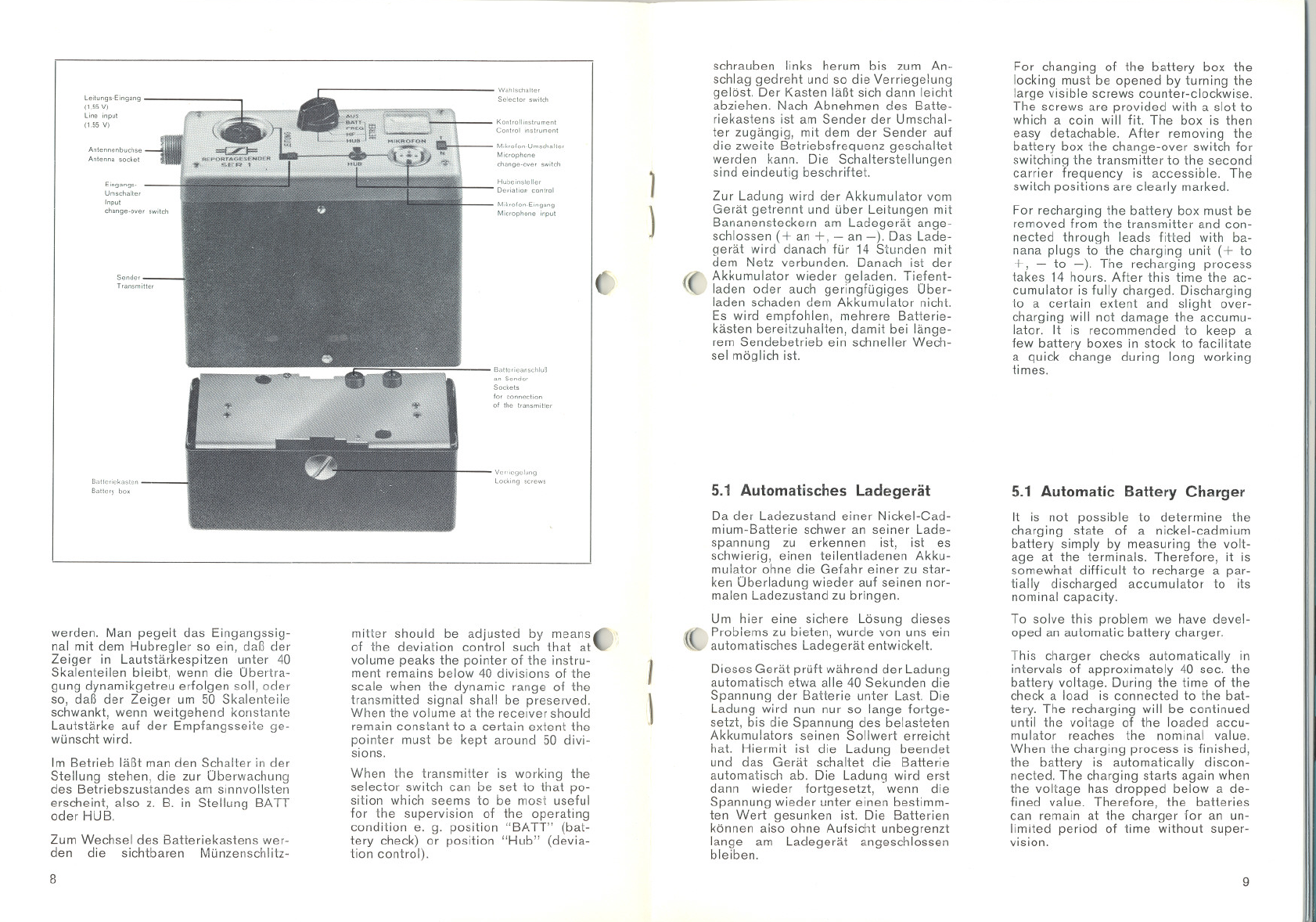
---
I
W,hlooh,""
Soleelol ,witeh
(1.55
Kocllolll"tromeol
Coctrol 10ol,omeol
Mlkroloo-Umooh"",
Mbophoco
ohoogo-om ,witoh
Hobol,,'olI"
D,,;,lIoo coollOl
M;nophooe
B,tt,,;eoooohloll
00 Secd"
Sookel,
'01 ooccod,oo
01 'ho I"oomltter
VCllre901009
LOiklOg
Bott", 1,°'
werden. Man pegelt das Eingangssig-
nal mit dem Hubregler so ein, daß der
Zeiger in Lautstärkespitzen unter 40
Skalenteilen bleibt, wenn die Obertra-
gung dynamikgetreu erfolgen soll, oder
so, daß der Zeiger um 50 Skalenteile
schwankt, wenn weitgehend konstante
Lautstärke auf der Empfangsseite ge-
wünscht wird.
mitter should be adjusted by means
O
"
of the deviation control such that at
volume peaks the pointer of the instru-
ment remains below 40 divisions of the
scale when the dynamic range of the
transmitted signal shall be preserved,
When the volume at the receiver should
remain constant to a certain extent the
pointer must be kept around 50 divi-
sions,
Im Betrieb läßt man den Schalter in der
Stellung stehen, die zur Oberwachung
des Betriebszustandes am sinnvollsten
erscheint, also z, B. in Stellung BATT
oder HUB.
When the transmitter is working the
selector switch can be set to that po-
sition which seems to be most useful
for the supervision of the operating
condition e. g. position "BA TT" (bat-
tery check) or position "Hub" (devia-
tion control),
Zum Wechsel des Batteriekastens wer-
den die sichtbaren Münzenschlitz-
8
(~
)
)
schrauben links herum bis zum An.,
schlag gedreht und so die Verriegelung
gelöst. Der Kasten läßt sich dann leicht
abziehen, Nach Abnehmen des Batte-
riekastens ist am Sender der Umschal-
ter zugängig, mit dem der Sender auf
die zweite Betriebsfrequenz geschaltet
werden kann, Die Schaltersteilungen
sind eindeutig beschriftet.
Zur Ladung wird der Akkumulator vom
Gerät getrennt und über Leitungen mit
Bananensteckern am Ladegerät ange-
schlossen (-+-an +, - an -), Das Lade-
qerät wird danach für 14 Stunden mit
dem Netz verbunden. Danach ist der
d"
,
Akkumulator wieder ~elad~n. Tiefent-
\.\.,. laden oder auch geringfügiges Uber-
laden schaden dem Akkumulator nicht.
Es wird empfohlen, mehrere Batterie-
kästen bereitzuhalten, damit bei länge-
rem Sendebetrieb ein schneller Wech-
sel möglich ist.
5.1 Automatisches Ladegerät
Da der Ladezustand einer Nickel-Cad-
mium-Batterie schwer an seiner Lade-
spannung zu erkennen ist, ist es
schwierig, einen teilentladenen Akku-
mulator ohne die Gefahr einer zu star-
ken Oberladung wieder auf seinen nor-
malen Ladezustand zu bringen.
1
\
Um hier eine sichere Lösung dieses
rfi"'" Problems zu bieten, wurde von uns ein
~ automatisches Ladegerät entwickelt.
Dieses Gerät prüft während der Ladung
automatisch etwa alle 40 Sekunden die
Spannung der Batterie unter Last. Die
Ladung wird nun nur so lange fortge-
setzt, bis die Spannung des belasteten
Akkumulators seinen Sollwert erreicht
hat. Hiermit ist die Ladung beendet
und das Gerät schaltet die Batterie
automatisch ab, Die Ladung wird erst
dann wieder fortgesetzt, -wenn die
Spannung wieder unter einen bestimm-
ten Wert gesunken ist. Die Batterien
können also ohne Aufsicht unbegrenzt
lange am Ladegerät angeschlossen
bleiben.
----...
For changing of the battery box the
locking must be opened by turning the
large visible screws counter-clockwise.
The screws are provided with a slot to
which a coin will fit. The box is then
easy detachable, After removing the
battery box the change-over switch for
switching the transmitter to the second
carrier frequency is accessible. The
switch positions are clearly marked,
For recharging the battery box must be
removed from the transmitter and con-
nected through leads fitted with ba-
nana plugs to the charging unit (+ to
+, - to -). The recharging process
takes 14 hours. After this time the ac-
cumulator is fully charged- Discharging
to a certain extent and slight over-
charging will not damage the accumu-
lator. It is recommended to keep a
few battery boxes in stock to facilitate
a quick change during long working
times.
5.1 Automatie Battery Charger
It is not possible to determine the
charging state of a nickel-cadmium
battery simply by measuring the volt-
age at the terminals. Therefore, it is
somewhat difficult to recharge a par-
tially discharged accumulator to its
nominal capacity.
To solve this problem we have devel-
oped an automatic battery charger.
This charger checks automatically in
intervals of approximately 40 sec. the
battery voltage. During the time of the
check a load is connected to the bat-
tery. The recharging will be continued
until the voltage of the loaded accu-
mulator reaches the nominal value.
When the charging process is finished,
the battery is automatically discon-
nected. The charging starts again when
the voltage has dropped below a de-
fined value. Therefore, the baHeries
can remain at the charger Tor an un-
limited period of time without super-
vision.
9











